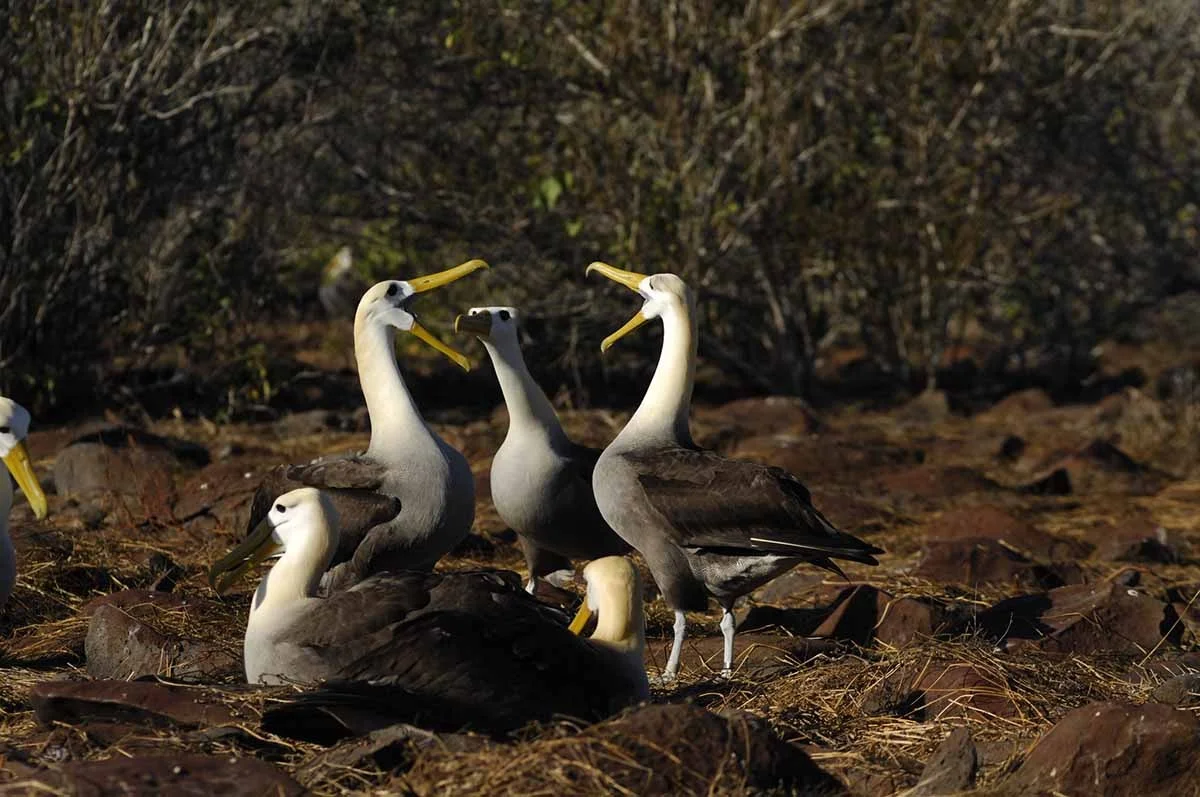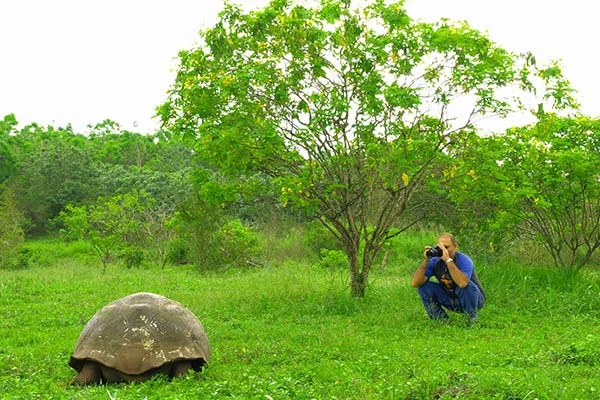
Galapagos Islands Wildlife Events Calendar
Galapagos Seasonal Wildlife Calendar of Natural Montly Events
The Galapagos Islands’ wildlife is truly exceptional as the endemic species never developed fear of humans due to the isolated location of the Archipelago. The Islands are pristine as it´s free of introduced and invasive species.
The species that arrived to the Galapagos survived mainly by evolving in a certain niche and adapting to the natural environment of our remote Archipelago. There is no argument that the natural biodiversity of the islands and its Marine Reserve makes the Galapagos a unique living paradise-laboratory of evolution.
Our carefully made wildlife activity calendar will allow you to you know first-hand what is going on each month of the year in the Enchanted Islands; this calendar is a reference to customary wildlife activity and behavior and so it may differ from reality or eventual natural changes as animals can be unpredictable as part of their constant adaptation to their habitat.
As a useful tool to help you with your travel plans, we have provided animal highlights information on a monthly basis. You can download our Calendar in the below link or click on each month in the wildlife activity calendar to see the marvelous natural events that will be part of your Galapagos journey!
We invite you to witness the amazing natural events that takes place in the Galapagos paradise on board an exclusive sailing cruise like Catamaran Horizon or Yacht Grand Majestic.

- The beginning of the rainy season
- Land birds start nesting, generally after the first rain
- On Hood (Española) Island, adult marine iguanas become brightly colored (green & red + black)
- The green sea turtles arrive at beaches in the Galapagos for egg laying period
- Land iguanas begin reproductive cycles on Isabela Island
- Both, water and air temperatures rise and stay warm until June
- The ideal time for snorkeling
- On Floreana Island, greater flamingos start nesting
- Bahama pintail ducks (Black-tailed pintail) start their breeding season
- Nazca (masked) boobies on Hood are at the end of their nesting season
- Marine iguanas nest on Santa Cruz Island
- The highest water temperature reaches 25C (77F). This temperature remains constant until April
- Very few penguins are sighted at Bartolome Island (most have followed the cool waters back to the west or near upwelling areas)
- Nesting season of the Galapagos dove reaches its peak
- The rainy season reaches the highest precipitation (this does not mean it rains every day).
- Sporadic tropical rains, intense sun, and hot climate. Air temperature can reach up to 30C (86F). Humidity is high.
- Marine iguanas nest on Fernandina
- March 21st, the beginning of the summer (equinox) signals the arrival of the waved albatross to Española.
- Even the western islands have warm waters where snorkeling is excellent. Punta Vicente Roca (Isabela) can be an amazing site. Penguins still active in the water, next to tropical fish! (How bizarre!)
- Some shores, especially those facing the north side, can receive deep surge (ola de fondo) coming from the northern currents. Wet landings at places like Puerto Egas, Gardner Bay, Bartolome can sometimes be a challenge.
- Snorkelers will remain long periods of time in the water by choice, marine life is very active.
- Massive arrival of waved albatrosses to Española. Amazing courtship starts.
- End of hatching season of the giant tortoises
- Eggs of green sea turtles begin to hatch
- Eggs of land iguanas hatch on Isabela
- While the rains have ended, the islands quite continue green
- Good visibility in the water for snorkelers
- Perhaps, together with May, the best months in Galapagos (weather, animals, water temperature)
- North Seymour’s blue-footed boobies begin their courtship
- Sea turtles are still hatching on Gardner Bay, Punta Cormorant, and Puerto Egas
- Most of the marine iguanas’ eggs hatch from nests on Santa Cruz
- Palo santo trees begin to shed their foliage
- Waved albatross on Española start laying their eggs
- Band-rumped storm petrels begin their first nesting period
- The beginning of the garúa season
- Giant tortoises on Santa Cruz Island migrate from the highlands to the lowlands in search of suitable nesting places
- The beginning of the nesting season of giant tortoises
- Southeast trade winds return. Currents become a bit stronger. Seas pick up in surge and wave action.
- Many red pouches by males of Magnificent Frigatebirds on North Seymour.
- Southern migrants have started their journey towards the north. Galapagos is a rest stop for such birds. Some species of cetaceans also follow this pattern of migration.
- Some groups of Humpback whales that migrate up to equatorial latitudes along the coast of Ecuador, can reach the Galapagos too.
- Seabird communities are very active (breeding), especially the Blue-footed boobies on Española.
- Flightless cormorants perform beautiful courtship rituals and nesting activities on Fernandina.
- If you walk along the shores of Puerto Egas (Santiago Island) you can find American oystercatchers nesting.
- Lava lizards initiate mating rituals until November
- Cetaceans (whales & dolphins) are more likely to be observed, especially off the western coast of Isabela
- Great month to see the four stages of nesting in Blue-footed boobies: eggs, chicks, juveniles, and subadults.
- Water temperature does not reach more than 21C (68F)
- Galapagos hawks court on Española and Santiago
- Nazca (masked) boobies and Swallow-tailed gulls nest on Genovesa Island
- The temperature of the ocean drops to 18C (64F), which obviously varies according to the geographic zones among the islands.
- Migrant shore birds start to arrive and stay on the islands until March
- Giant tortoises return to the highlands of Santa Cruz
- Oceans are quite choppy, currents at the strongest levels, a surge can be expected along the shores that face west or south
- Pupping season (births) of sea lions has started. Western and central islands are common places for such sightings.
- Peak of the cold (garúa) season
- The air temperature reaches its lowest levels (19C-66F)
- Galapagos Penguins show remarkable activity on Bartolome.
- Since May swimmers and snorkelers can be delighted at Bartolome with penguins active at the surface or torpedo-like while underwater.
- Sea lions are very active. Females have reached estrus stage, and so harem-gathering males are constantly barking and fighting. Shore fighting is heavy. Western and central islands are the most active ones in terms of sea lions’ activities.
- Most species of seabirds remain quite active at their nesting sites
- Lava herons start nesting until March
- The Galapagos Fur Seals (subspecies of Sea lions) begin their mating period
- Blue-footed boobies raise chicks all over Española and Punta Vicente Roca (Isabela)
- Giant tortoises are still laying eggs
- Days are not always sunny. Garúa can be expected in most locations, except the western islands where most days have a misty start but after few hours of daylight it burns off.
- Sunrises in the west can be quite beautiful after the garúa covers only certain locations of the western volcanoes.
- Summits are clear, but low-lying fog covers the shoreline.
- Pupping of sea lions continue.
- Sea lions are sexually active in the eastern part of the archipelago.
- Breeding season for the brown noddies
- Some species of jellyfish can be seen around the islands.
- The genus Physalia is commonly seen floating around Gardner and Tortuga Islets. Some can also be seen stranded at the shores of the Flour Beach at Floreana.
- Band-rumped storm petrels begin their second nesting period
- Seas are calm. Southeast trade winds have decreased strength. Water temperatures are slowly rising.
- Generally great weather due to transition between one season and the next one
- Good visibility for snorkelers
- Sea lion pups (especially at Champion Islet) play aqua-aerobics next to snorkelers. Most pups here are curious enough to nibble at fins of snorkelers. The average age of most pups is 3-4 months.
- Hatching of giant tortoise’s eggs begins and lasts until April
- Green sea turtles display their mating behavior
- The rainy season begins, all of the plants of the dry zone produce leaves. Galapagos become “green”.
- The first young waved albatrosses fledge
- Great weather



